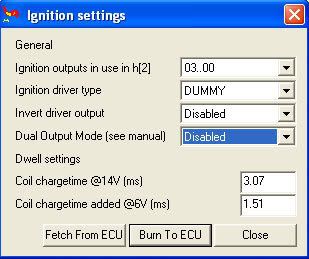
Ignition outputs are wired like
Firing order: => 1 2 4 3 (not 1 3 4 2)
Bad wiring: From bottom to top ^.
- cyl 3 ignch2 EC36pin34 output 20
- cyl 4 ignch7 EC36pin10 output 70
- cyl 2 ignch6 EC36pin24 output 60
- cyl 1 ignch3 EC36pin36 output 30
This wiring is not suitable for ign_dualout (so with 4 coils, you would need camsync).
Recommended wiring: From bottom to top ^.
- cyl 3 ignch7 EC36pin10 output 70
- cyl 4 ignch2 EC36pin34 output 20
- cyl 2 ignch6 EC36pin24 output 60
- cyl 1 ignch3 EC36pin36 output 30
ign_out=72
h[2]=70 30 70 30 00 00 00 00
The reason for this is because with ign_dualout (N, N-1 rule),
- selecting ignch7 will also fire ignch6
- selecting ignch3 will also fire ignch2
My fuse keeps blowing everytime I crank. I have setting coilcharge time to 0.58 ms, but still it keeps blowing.
Not that ignition preparation status was not enough for wiring (and configuration), yet alone to start cranking !
I have seen this problem, it turned out that the car I worked had a CDI ignition system from the factory and CDI coils are not compatible with an inductinve ignition system. In my case I could get it to give very weak spark at 0.1-0.2ms dwell and 0.0 added at 6v. Measure the primary resistance of the coil and report that, the result of the resistance measurement may not be conclusive but it's a start. - Jörgen
10A shared fuse for 2 coils is not recommended. Prefer 4..5A/coil for initial startup. It should idle OK and revv upto at least 4000 RPM without blowing. Than upgrading to 7.5A / coil for production minimixes the chance for blowing at bad time.
Do NOT EVEN think about a 20 A fuse !. 10A is already too much, it might allow peak 15A so it might not provide proper protection.
Scope of my primary
